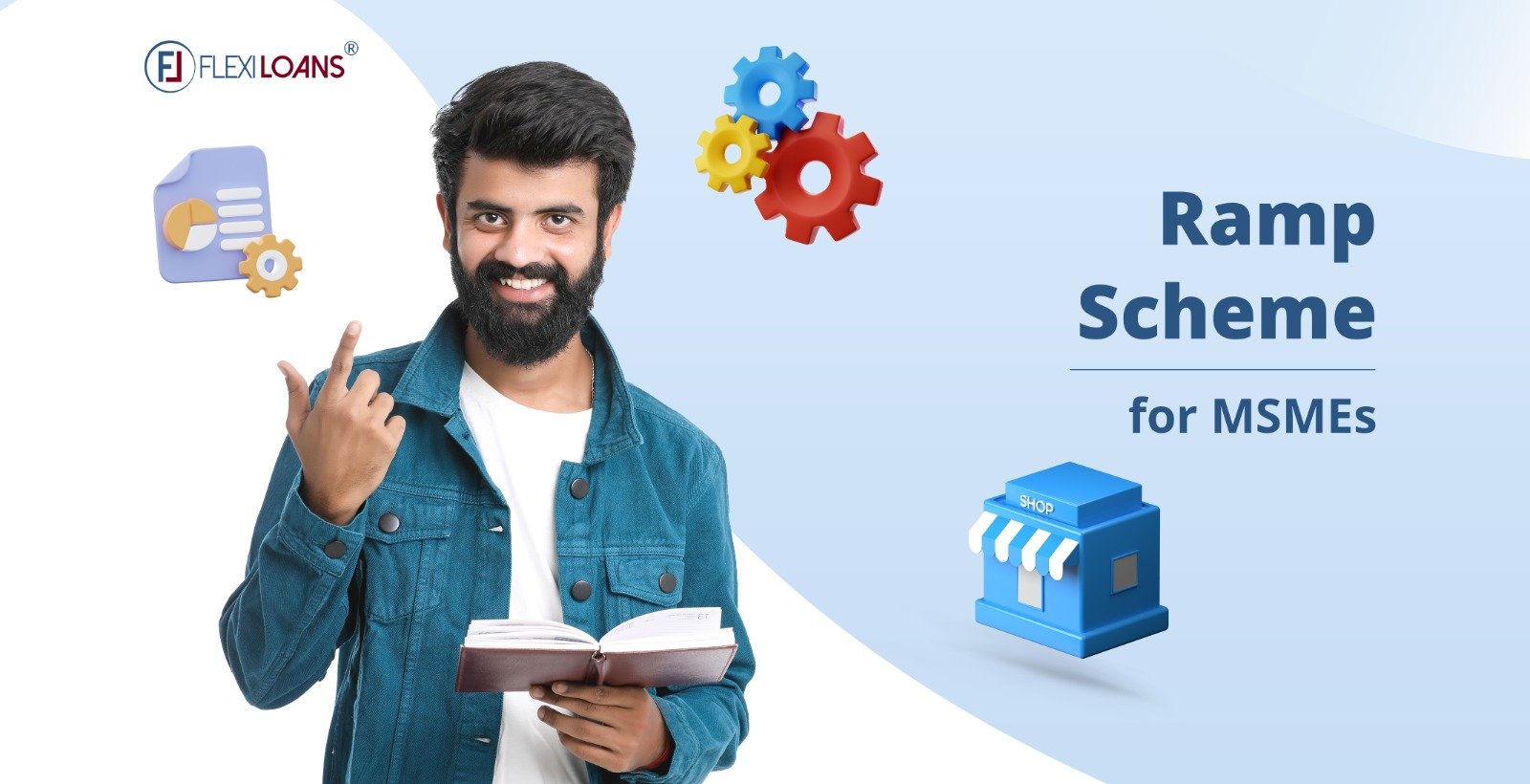Jan 24, 2024
Sep 29, 2025

If you are a micro, small, or medium enterprise (MSME) owner in India, you might be aware of your sector’s challenges, especially during the Covid-19 pandemic. You might have struggled with issues such as lack of access to credit, delayed payments, low productivity, poor quality standards, limited market reach, and outdated technology. You might have wondered if there is any solution to focus on these challenges and improve the performance of your business.
Well, there is good news for you. The Government of India has launched a new scheme called RAMP to help you overcome these challenges and boost your business growth. RAMP scheme’s full form is Raising and Accelerating MSME Performance.
What is the RAMP Scheme?
The RAMP scheme is a program to support the growth and development of India’s MSME sector. MSME or Micro, Small, and Medium Enterprises are businesses with less than 250 employees and less than ₹5 crores in annual turnover for micro-enterprises, ₹50 crores for small-enterprises, ₹250 crores for medium-enterprises.
The RAMP programme aims to improve India’s MSMEs’ productivity, competitiveness, and resilience and create more jobs, income, and exports. The scheme also complements the Atma Nirbhar Bharat Mission, a vision to make India self-reliant and prosperous.
The scheme was launched on June 30, 2022, by the Prime Minister of India, with a total outlay of ₹6,062.45 crore, out of which ₹3,750 crore is a loan from the World Bank and India funds the remaining ₹2,312.45 crore. The scheme’s duration is five years (2021-22 to 2025-26).
Components of RAMP Scheme
Formulating strategic investment initiatives is a pivotal element of the RAMP MSME scheme framework. Each union territory and the selected states covered within this framework must prepare a comprehensive engagement plan to locate and engage micro-enterprises.
This approach not only facilitates the establishment of objectives but also aids in pinpointing key challenges and deficiencies. Furthermore, it enables the estimation of necessary funding for private sector undertakings, including those in rural and non-agricultural sectors, enterprises owned by women, sustainable energy ventures, and the wholesale and retail sectors.
The governance and supervision of this program will fall under the purview of a premier national council for MSMEs. The MSME minister will preside over this council, which a dedicated secretariat and delegates from various governmental departments will support.
Objectives and Features of RAMP Scheme
1. Impact Enhancement of Existing MSME Schemes
RAMP scheme aims to enhance the impact of existing MSME schemes, such as CGTSME, Innovative MSME, Samadhaan, ZED, and Procurement and Marketing Support. These schemes are there to provide various benefits to MSMEs, such as:
- CGTSME: This scheme provides credit guarantee cover to collateral-free and third-party guarantee-free loans up to ₹ 2 crores extended by eligible lending institutions to new and existing MSMEs.
- Innovative MSME: This scheme supports creative ideas and technologies of MSMEs by providing financial assistance for patent registration, technology acquisition, and commercialisation.
- Samadhaan: This scheme facilitates the timely and effective settlement of payment disputes between MSMEs and their buyers through an online portal.
- ZED Scheme (Zero Defect Zero Effect): This scheme aims to better the quality and environmental performance of MSMEs by providing them with assessment, rating, certification, and handholding support.
- Procurement and Marketing Support Scheme: This scheme assists MSMEs in participating in domestic and international trade fairs, exhibitions, and buyer-seller meets and creating awareness about various government schemes and initiatives.
The scheme will strengthen the implementation and outreach of these schemes by providing additional resources, capacity building, monitoring, and evaluation. It will also leverage digital platforms, such as Udyam Registration, Udyam Sakhi, and Champions, to increase the accessibility and awareness of these schemes among MSMEs.
2. Fostering Innovation, Ideation and Incubation
This scheme will foster innovation, ideation and incubation of new businesses and entrepreneurship in the MSME sector. It will support developing quality standards, improving practices and processes, enhancing market access, deploying technological tools, and adopting Industry 4.0 by MSMEs. Some of the key features of the scheme in this regard are:
- It will establish an Innovation and Technology Centres (ITCs) network to support MSMEs with technical and business development support. The ITCs will offer product design, testing, prototyping, validation, certification, technology transfer, and incubation.
- The scheme will promote the adoption of Industry 4.0 technologies by MSMEs, such as artificial intelligence, IoT, cloud computing, big data, robotics, and 3D printing. The scheme will provide MSMEs with financial assistance, training, and mentoring to upgrade their technology and processes.
- It will facilitate the creation of MSME clusters and value chains within and across states to enhance MSMEs’ competitiveness and market access. The scheme will support the development of common infrastructure, branding, marketing, and e-commerce platforms.
3. Implementing Regulatory, Financial, and Implementation Reforms
This scheme aims to implement various reforms to provide targeted interventions to MSMEs across recognised challenge areas. It will address the issues of policy coordination, institutional capacity, financial inclusion, and environmental sustainability in the MSME sector. Some of the key features of the RAMP scheme in this regard are:
- It will enhance the policy coordination and institutional capacity of the Ministry of MSME and the state governments to design, implement, and monitor the MSME schemes and programs. It will also improve the MSME sector’s data collection, analysis, and dissemination.
- The scheme will improve MSMEs’ financial inclusion and access to credit by strengthening the credit guarantee mechanism. It will facilitate the use of FinTech solutions and promote alternative business loan financing sources, such as venture capital, angel funds, and crowdfunding.
- It will address delayed payments to MSMEs by strengthening the enforcement of the MSME Development Act, 2006, and the Insolvency and Bankruptcy Code, 2016. The scheme will also provide legal and advisory support to MSMEs to resolve payment disputes.
- It will support the greening of MSMEs by promoting the adoption of cleaner production technologies, renewable energy sources, waste management practices, and resource efficiency measures. The scheme will also provide incentives and recognition for MSMEs adopting green methods.
Benefits of the RAMP Scheme
The RAMP scheme can provide various benefits to MSMEs, such as:
- Under the RAMP scheme, businesses can access technology, knowledge, and innovation. This helps improve the productivity, quality, and competitiveness of MSMEs.
- The scheme creates MSME clusters and value chains. It also facilitates the businesses’ participation in domestic and international trade fairs, exhibitions, and buyer-seller meets. All this increases the market access and opportunities for MSMEs.
- It helps reduce business costs and improves the ease of doing business for MSMEs. RAMP achieves this by simplifying the regulatory framework, providing credit guarantees and financial assistance, and resolving payment disputes.
- It helps in generating employment and income opportunities for MSMEs. RAMP does this by fostering new businesses and entrepreneurship and supporting the formalisation and growth of existing MSMEs.
- It complements the Atma Nirbhar Bharat mission by making MSMEs self-reliant, resilient, and sustainable.
RAMP Scheme — Eligibility, Documentation and Application Process
To be eligible for the scheme, the MSME should be registered under the MSMED Act, 2006 and have a valid Udyog Aadhaar Number (UAN). The documents required for the scheme are:
- Duly filled and signed application form
- Proof of MSME registration and UAN
- Bank account details and GSTIN
- A project report that outlines the company’s objectives, methodology, project outcomes
- Detailed business plan
- Identity proof
- Address proof
- Any other documents as specified by the scheme guidelines
- The application process for the scheme is online. A separate RAMP portal will be developed shortly, where the MSMEs can apply for the scheme and access its benefits.
Conclusion
RAMP is a scheme that can potentially transform the MSME sector in India. It aims to make this sector more resilient, competitive, and sustainable. By providing financial and non-financial support to MSMEs, RAMP can help them overcome the challenges posed by the pandemic and the changing market dynamics and enable them to contribute to the country’s economic growth and social development.
While the RAMP scheme is transforming the MSME landscape, small business loans can provide the necessary funds to deal with unexpected or planned expenses. With an MSME loan or machinery loan from a company like FlexiLoans, you can ensure you never miss out on any opportunities that may come your way. Have all the mandatory documents handy to get an affordable business loan interest rate.
FAQs
RAMP Yojana’s full form is Raising and Accelerating MSME Productivity. It is a scheme by the Ministry of MSMEs, supported by the World Bank, to help the MSME sector recover from the COVID-19 pandemic and become more competitive and resilient.
Ans: The goals of the RAMP programme are to:
-Enhance the impact of existing MSME schemes on competitiveness, innovation, quality, and market access.
-Address the challenges and gaps in the MSME sector
-Foster collaboration with states and institutions
-Support the Atma Nirbhar Bharat Mission
Ans: The benefits of the RAMP Scheme are:
1. Improved access to credit and liquidity for MSMEs at affordable rates and terms.
2. Increased productivity, efficiency, and quality
3. Enhanced market linkages and opportunities for MSMEs
4. Strengthened innovation and technology adoption by MSMEs
5. Creation of employment and livelihoods for millions
6. Reduced environmental impact and carbon footprint of MSMEs
The RAMP Scheme lasts five years, from 2021-22 to 2025-26. The total budget of the RAMP Scheme is Rs. 6,062.45 crore, out of which Rs. 3,750 crore is a loan from the World Bank, and the Government of India funds the remaining Rs. 2,312.45 crore.
The implementation of the RAMP Scheme will initially be in five states, namely Gujarat, Maharashtra, Punjab, Rajasthan, and Tamil Nadu. These states account for 54% of India’s MSMEs. The scheme will be extended to other states in due course, based on their performance and readiness.
Ans: RAMP Scheme will cover the following MSME schemes:
-Credit Linked Capital Subsidy and Technology Upgradation Scheme (CLCS-TUS)
-Credit Guarantee Scheme for Subordinate Debt (CGSSD)
-Interest Subvention Scheme for Incremental Credit to MSMEs
-Prime Minister’s Employment Generation Programme (PMEGP)
-Scheme of Fund for Regeneration of Traditional Industries (SFURTI)
-A Scheme for Promotion of Innovation, Rural Industry and Entrepreneurship (ASPIRE)
-Procurement and Marketing Support Scheme (PMS)
-Entrepreneurship and Skill Development Programme (ESDP)
MSMEs should generally be registered under the Udyam Registration Portal and have a valid Udyam Registration Number (URN). They should also comply with the definition of MSMEs as per the revised criteria, which is effective from July 1, 2020.
Ans: Some of the documents mandatory for the RAMP Scheme are:
-Udyam Registration Certificate
-Aadhaar Card
-PAN Card
–GST Registration Certificate
-Bank Account Details
-Project Report or Business Plan







